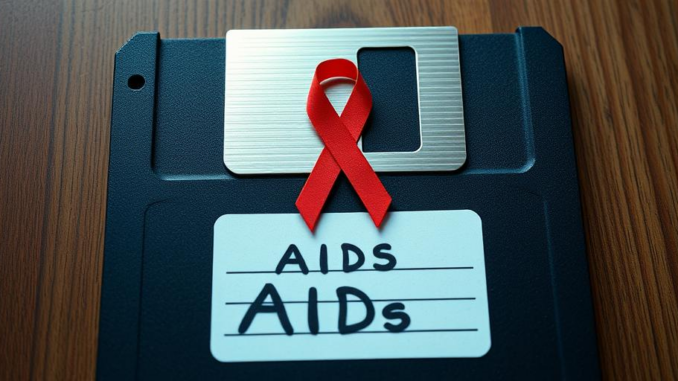
Summary
This article delves into the fascinating story of the AIDS Trojan, the world’s first ransomware attack, which targeted the 1989 World Health Organization’s AIDS conference. It explores the attack’s mechanics, the unusual perpetrator, and the lasting impact it had on cybersecurity. The AIDS Trojan serves as a stark reminder of the persistent evolution of cyber threats, from floppy disks to sophisticated network intrusions.
Explore the data solution with built-in protection against ransomware TrueNAS.
Main Story
It’s 1989, the World Health Organization’s AIDS conference is in full swing. Can you imagine the scene? Attendees, presumably focused on critical health discussions, were handed seemingly harmless floppy disks, each labeled “AIDS Information – Introductory Diskettes”. Little did they know, that these disks were ticking time bombs. Inside lurked the AIDS Trojan, the world’s first ransomware. It was a dark foreshadowing of a digital plague that would, unfortunately, get a lot worse.
Joseph Popp, a Harvard-trained evolutionary biologist and an AIDS researcher, was the mastermind behind this pioneering cyberattack. He distributed about 20,000 of these infected disks, effectively setting the stage for what we now recognize as the first large-scale ransomware attack. The Trojan itself was actually pretty simple; for that time anyway. It would hide, quietly counting the times the computer was booted. Once it hit 90 boots, bam, it would spring to life, hiding directories and encrypting file names on the C drive. Then, up popped a message demanding a ransom of $189. They wanted it sent to a P.O. box in Panama, registered under the totally legit-sounding name “PC Cyborg Corporation.” You couldn’t make this stuff up.
Now, the encryption used was basic, I mean, you could circumvent it with tools that were easy to find and use, but, at that time it was revolutionary. It exploited the trust people had; conference attendees wouldn’t suspect an issue, especially given the topic of the conference. This was in the days of floppy disks of course. A totally different world from todays sophisticated phishing campaigns and network intrusions. However, at its heart, the principle was the same: hold data hostage for financial gain. You know what they say: history might not repeat, but it sure does rhyme.
Popp’s motives? Well, those are still debated. Some speculate it was hacktivism, a protest against the perceived high cost of AIDS treatment. Others think his actions stemmed from a deeper psychological disturbance, especially given his later erratic behavior and legal troubles. Whatever his intention, Popp, unknowingly, launched a new era of cybercrime. It’s almost like he stumbled into it, inadvertently.
Because of the AIDS Trojan, despite its primitive nature compared to what we have now, it served as a blueprint for future ransomware attacks. It showed how vulnerable individuals and organizations were. It highlighted how easy financial gain could be through data manipulation. The whole thing also underscored, and this is important, the need for cybersecurity awareness, even before the internet was the way it is today. The ease with which the AIDS Trojan was decrypted demonstrated that stronger encryption was needed. And the battle against that still continues.
And its legacy? It extends so far beyond its initial impact. It foreshadowed the increasing sophistication and prevalence of ransomware attacks. From CryptoLocker to WannaCry, ransomware has morphed into a global threat. A real problem that impacts critical infrastructure, businesses and even your neighbor down the street. The rise of cryptocurrency has fueled cybercriminals, giving them a secure and anonymous way to receive ransom payments. Its not ideal.
The AIDS Trojan serves as a constant reminder. Cyber threats are always evolving. The floppy disk is a relic of the past. But the principles of social engineering, exploitation of vulnerabilities, and financial extortion? Those are still here, at the heart of modern attacks. That said, the story of the AIDS Trojan is not just some historical anecdote. It’s a cautionary tale, one that emphasizes the need to be vigilant, proactive with security measures, and constantly educate yourself on evolving cyber threats. As we navigate this digital world, the lessons from that first ransomware attack continue to be relevant, don’t you think?


So, a Harvard-trained biologist thought floppy disks were the ideal distribution method for his “groundbreaking” malware? I’m curious, was dial-up internet too sophisticated for him at that point?
That’s a great point! It’s easy to look back and wonder why he didn’t use the internet, but dial-up was still relatively new and not as widespread in 1989. Floppy disks were the USB drives of their time, making them a more accessible method for distribution. It’s a funny contrast to today’s sophisticated methods!
Editor: StorageTech.News
Thank you to our Sponsor Esdebe – https://esdebe.com
A Harvard biologist distributing malware via floppy disk in 1989? That’s like using a carrier pigeon to send a phishing email today! I wonder if he considered a more modern approach, like engraving the ransomware code onto stone tablets? It might have been more secure, if a bit less portable!
That’s a hilarious comparison! The stone tablet approach might have given new meaning to “hard drive.” Seriously though, it highlights how much the threat landscape has changed. Imagine trying to explain ransomware to someone in 1989! What do you think the next evolution in cybercrime will look like?
Editor: StorageTech.News
Thank you to our Sponsor Esdebe – https://esdebe.com
The mention of Popp’s motives is intriguing. Was it truly hacktivism, or something more personal? Exploring the psychological aspects of early cybercriminals could offer insights into today’s threat actors and their motivations.